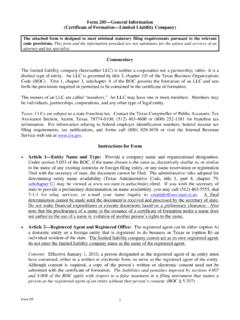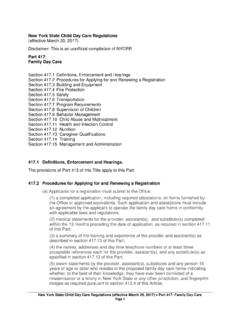Transcription of Economics of Unconventional Gas
1 OGJ Unconventional Gas Article #5 FINAL 1 July 24, 2007 Economics of Unconventional Gas Michael Godec, Tyler Van Leeuwen and Vello Kuuskraa, Advanced Resources International, Arlington, VA With the sharp recent rise in well drilling and particularly well stimulation costs, some are concerned that much of the Unconventional gas resource in the is becoming uneconomic. Concerns about the economic viability of Unconventional gas have been raised since the initial pursuit of this resource, sometimes rightly so. However, in our view, improvement in the Unconventional gas knowledge base and technology progress using industry/government partnerships can maintain the economic viability of this large, often marginally productive resource. Past reservoir characterization methods and traditional means of linking a wellbore to the low permeability Unconventional gas reservoir are no longer sufficient. As such, the discussion of the economic viability of Unconventional gas is as much a story of technological advance and the pursuit of efficiency, as introduced in the third and fourth articles in this series, as it is a story of costs, financial risks and wellhead prices.
2 Even though the overall economic trends for Unconventional gas are currently unfavorable - - with finding and development (F&D) costs rising faster than wellhead prices - - significant examples of economic success nonetheless exist. This fifth article in the series presents a number of examples of how selected companies, with diligent pursuit of knowledge and technology, have converted previously judged uneconomic Unconventional gas plays into economically viable prospects. In addition, this article discusses potential actions that could help maintain the future economic viability of Unconventional gas in the Finally, the article describes several threats and opportunities on the horizon that could influence the future Economics of domestic Unconventional gas. OGJ Unconventional Gas Article #5 FINAL 2 July 24, 2007 Outlook for Cost Increases. How long will the sharp increases in well drilling and completion costs continue, thus harming the economic viability of Unconventional gas?
3 With increases in natural gas prices and the subsequent boom in Unconventional gas development, oil field service companies have been able to increase the prices they charge for their services and products. For example, rig rates that were quoted at $12,000 per day several years ago are now routinely priced at $18,000 to $20,000 or more per day; hydraulic fracturing services and tubulars have seen similar, if not higher, rates of pricing growth. In our view, the rise in well drilling and completion costs is coming to a close - - in part due to expansions in service industry capacity, and in part due to producer reluctance to accept these high, increasing prices. For example: The supply of domestic drilling rigs, that account for 20% to 25% of the costs of a typical well, has expanded greatly, with over 200 land rigs added last year and another nearly 300 land rigs expected this year. Several of the active Unconventional gas producers, such as Chesapeake, Southwestern and Williams, facing a tight, costly rig market, have taken the extraordinary step of contracting for purpose built rigs and establishing their own drilling companies.
4 The supply of high pressure pumping services (for well stimulation and hydraulic fracturing), which account for 30% to 35% of the costs of a typical Unconventional gas well, increased by about 25% (by about 700,000 HHP) last year. With expanded service capacity and several new companies entering this line of business, there is promise that pumping service costs will stabilize and possibly decline. Following sharp increases in the price of steel, the prices for oil field tubulars have stabilized and even show a slight decline this year. Tubulars account for 10% to 15% of the cost of a typical Unconventional gas well. OGJ Unconventional Gas Article #5 FINAL 3 July 24, 2007 Nonetheless, these higher drilling rig, pumping service, and tubular prices place even greater pressures for relentless pursuit of efficiencies in developing Unconventional gas, as is further discussed later in this article. Economics of Rocky Mountain Unconventional Gas Plays.
5 Our Model for Unconventional Gas Supply (MUGS) provides us with an up-to-date perspective on the economic viability of 94 distinct Unconventional gas plays in the This economic model shows that using a long-term NYMEX gas price of $6/Mcf, 27 of these plays (holding 260 Tcf of recoverable resources) are economically viable, with another 21 plays (holding 140 Tcf of recoverable resources) being marginally economic . As confirmation and quality control for our model, we periodically review and examine the actual economic performance of Unconventional gas plays. A portion of our latest review is provided below. For the traditional Rocky Mountain Unconventional gas plays, we provide three examples of Unconventional gas costs and Economics , using public data provided by Bill Barrett Corporation and selected other producers, Table 1. The first example is for the Williams Fork/Measaverde tight gas sands of the S. Piceance Basin, now producing nearly one Bcfd.
6 This play provides a 36% rate of return (to Bill Barrett Corp) and requires a gas price of $ (at the CIG hub) to be economically viable. The second example is for the Big George coalbed methane play in the Powder River Basin. This play provides a 53% ROR and requires a $3/Mcf (at the CIG hub) to be economically viable. However, geologically less favorable portions of this coalbed methane play will have less robust Economics . OGJ Unconventional Gas Article #5 FINAL 4 July 24, 2007 The third example is for the new Wasatch/Mesaverde tight gas play in the Uinta Basin, outside the traditional Natural Buttes field area. This play has a 52% rate of return and requires a gas price of $ (at the CIG hub) to be economically viable. Optimization of well completions by EOG Resources is helping improve the economic returns for this gas play. Table 1. economic Performance of Three Established Unconventional Gas Plays Tight Gas Sands Williams Fork/Mesaverde S.
7 Piceance Basin Coalbed Methane Big George Powder River Basin Tight Gas Sands Wasatch/Mesaverde Uinta Basin Realized Gas Price 1 $ $ $ Less: Production Taxes ( ) ( ) ( ) LOE/Other ( ) ( ) ( ) F&D Costs ( ) 2 ( ) 3 ( ) 4 Net Margin $ $ $ ROR 36% 53% 52% Min. Required CIG Gas Price $ $ $ 1 Mid-2007 Rockies strip with BTU/sales adjustment 2 Assumes net EUR of Bcf/well and D&C costs of $ million 3 Assumes net EUR of Bcf/well and D&C costs of $ million 4 Assumes net EUR of Bcf/well and D&C costs of $3 million Economics of Emerging Unconventional Gas Plays.
8 Certain of the emerging Unconventional gas plays in the also exhibit attractive Economics . We start with a look at the Economics of the Deep Bossier tight gas play in East Texas. According to Chesapeake Energy, assuming average well costs of $10 million, average gross estimated ultimate recoveries (EURs) of 5 Bcf per well, and a realized wellhead gas price of $ per Mcf, this play can provide a ROR ranging from 70% to 100%, depending on the extent to which drilling costs decline with increasing experience, Table 2. OGJ Unconventional Gas Article #5 FINAL 5 July 24, 2007 A second example is in the Woodford gas shale in Southeast Oklahoma. Assuming well costs of $ million per well, average gross EURs of Bcf per well, and a realized gas price of $ per Mcf, this play can achieve RORs of 18% to 25%, depending on drilling costs, again according to Chesapeake Energy. Table 2. economic Performance for Two Emerging Gas Plays Tight Gas Sands Deep Bossier East Texas Gas Shales Woodford SE Oklahoma Realized Gas Price 1 $ $ EUR/Well Gross Bcfe Bcfe Net Bcfe Bcfe Cost/Well $10 million $ million F&D Cost $ $ ROR (%) Current Well Costs ~ 70% ~ 18% Reduced Well Costs (-15%) > 100% ~ 25% 1 Assumes a NYMEX Price of $7/Mcf and $ for gathering plus differentials.
9 A more speculative look involves the Economics of the emerging deep Dakota-Entrada-Navajo tight gas play in the Uinta Basin. Here, the initial well costs are in the range of $9 to $10 million for a 15,000 foot well. However, with expectations of achieving EURs per well of 5 to 6 Bcf, the Economics of this play appear viable, especially should well costs come down. The initial discovery well in this play tested at over 11 MMcfd (gross) in the Dakota, Entrada and Navajo formations, followed by wells testing at 6 to 10 MMcfd (gross) in the Navajo formation. Pursuing Efficiencies in Unconventional Gas Development. Faced with rising costs, industry is rigorously pursuing efficiencies and cost reductions in drilling, well completions and operations. A notable example is the reduction in days - - from 35 days in 2001 to 17 days in 2006 - - to drill a well in the tight Cotton Valley gas sands at Overton Field by Southwestern Energy, Figure 1. Similar gains in well drilling OGJ Unconventional Gas Article #5 FINAL 6 July 24, 2007 efficiencies are noted by other Unconventional gas producers such as EOG Resources and EnCana.
10 While significant efficiencies have been achieved in the past, the rate of efficiency gain has slowed in recent years due to reaching practical limits in what is possible with traditional well drilling methods and rigs. 1. Pursuing Efficiencies in Well Drilling and Completion. Continuation of this pursuit of efficiency (and costs savings) in well drilling and completion is illustrated by EnCana s experience. As the gains in drilling efficiencies with conventional rigs were diminishing, EnCana contracted for fit for purpose rigs and equipment that enabled it to reduce drilling days from over 40 days per well to about 30 days per well, with further gains expected in future years, Figure 2. EOG Resources has experienced similar efficiency improvements in its horizontal wells in the Wolfcamp tight gas sand play in the New Mexico portion of the Permian Basin. In this play, average well costs have dropped to about $830,000 per well for its most recent wells, compared to $ million per well in 2005, Figure 3.








